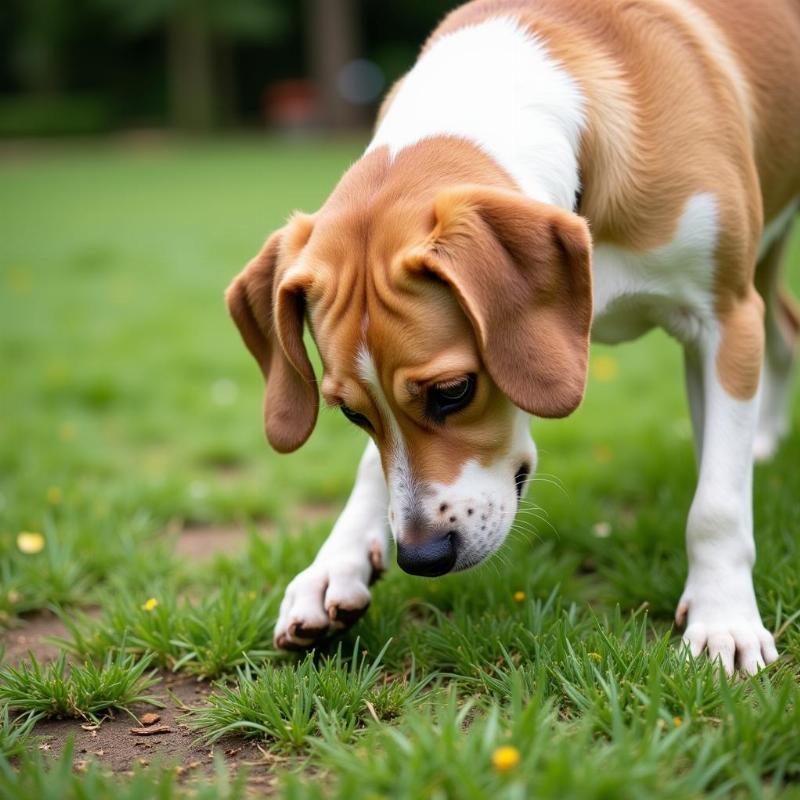Roundup, a common weed killer, is a concern for many dog owners. Understanding the potential risks and necessary precautions is crucial to keeping your furry friend safe. How long after spraying Roundup can your dog venture back into the treated area? This comprehensive guide addresses this critical question and provides essential safety information for dog owners in the US.
Understanding the Risks of Roundup Exposure for Dogs
Roundup’s active ingredient, glyphosate, has been the subject of numerous studies regarding its potential effects on animal health. While the Environmental Protection Agency (EPA) maintains that glyphosate is not likely to be carcinogenic to humans, its impact on dogs is less clear. Some studies suggest potential links between glyphosate exposure and canine lymphoma. It’s crucial to err on the side of caution and minimize your dog’s contact with this chemical.
 Dog Avoiding Roundup Treated Lawn
Dog Avoiding Roundup Treated Lawn
Exposure to Roundup can occur through direct contact with the sprayed vegetation, ingestion of treated plants, or even by walking on treated areas and then licking their paws. Symptoms of Roundup poisoning in dogs can vary, ranging from mild skin irritation and gastrointestinal upset to more serious issues like lethargy, vomiting, and difficulty breathing. If you suspect your dog has been exposed to Roundup and is exhibiting any of these symptoms, contact your veterinarian immediately.
Safe Timeframes for Dogs After Roundup Application
Determining a definitive safe timeframe for dogs after Roundup application is challenging, as various factors influence the drying and degradation process. These include the specific Roundup product used, the concentration applied, weather conditions (temperature, humidity, rainfall), and the type of vegetation treated.
As a general guideline, most manufacturers recommend waiting until the sprayed area is completely dry, which can take anywhere from a few hours to a couple of days. However, for optimal safety, especially for puppies, smaller dogs, or dogs with sensitive skin or health conditions, consider waiting a minimum of 72 hours, or even longer, before allowing your dog back into the treated area.
Minimizing Roundup Exposure and Alternative Weed Control
The best way to protect your dog from Roundup is to minimize or eliminate its use altogether. Consider pet-friendly weed control methods such as hand-pulling weeds, using natural herbicides like vinegar solutions, or employing preventative measures like mulching. If you must use Roundup, follow these precautions:
- Spray on a calm day: Avoid windy conditions that can carry the herbicide to unintended areas.
- Keep dogs indoors during and after application: Ensure your dog is safely inside until the treated area is thoroughly dry and you’ve waited the recommended timeframe.
- Water the treated area thoroughly: This helps dilute any remaining residue.
- Clean your dog’s paws: If your dog does accidentally come into contact with a treated area, wash their paws immediately with soap and water.
Creating a Pet-Safe Lawn and Garden
Prioritizing your dog’s safety extends beyond just Roundup. Consider the following tips for creating a pet-safe outdoor environment:
- Choose pet-friendly plants: Avoid toxic plants like lilies, azaleas, and sago palms.
- Store garden chemicals securely: Keep all herbicides, pesticides, and fertilizers out of reach of your dog.
- Provide shade and water: Ensure your dog has access to shade and fresh water, especially during hot weather.
- Regularly inspect your yard: Check for potential hazards like sharp objects, holes, or poisonous plants.
Conclusion
Protecting your dog from the potential risks of Roundup requires careful consideration and proactive measures. By understanding the recommended waiting periods, utilizing alternative weed control methods, and creating a pet-safe environment, you can ensure your furry friend enjoys a healthy and happy life outdoors. Remember, your veterinarian is always the best resource for specific advice regarding your dog’s health and safety.
FAQ
- What are the symptoms of Roundup poisoning in dogs? Symptoms can include skin irritation, vomiting, diarrhea, lethargy, and difficulty breathing.
- What should I do if my dog ingests Roundup? Contact your veterinarian or the ASPCA Animal Poison Control Center immediately.
- Are there any safe alternatives to Roundup? Yes, natural herbicides like vinegar solutions and manual weed removal are pet-friendly options.
- How long does it take for Roundup to degrade in the environment? The degradation rate varies depending on factors like temperature, soil type, and microbial activity.
- Is Roundup safe for other pets? Similar precautions should be taken for other pets, including cats and small animals.
- Can I use Roundup if I have a fenced yard? Even with a fence, drift from spraying can still affect your dog. It’s best to avoid using Roundup altogether if possible.
- Where can I find more information about pet-safe gardening? The ASPCA and the Pet Poison Helpline offer valuable resources on pet-safe gardening practices.
Beautdogs.us is your premier source for comprehensive dog care information in the US. We provide expert advice on dog breeds, grooming, nutrition, training, and overall well-being, catering to both novice and experienced dog owners. Explore our extensive resources and discover everything you need to know about providing the best care for your beloved canine companion. Contact us today for personalized support! Email: [email protected], Phone: +1 501-555-7529. Visit Beautdogs.us for more valuable insights and expert guidance on all things dog-related!